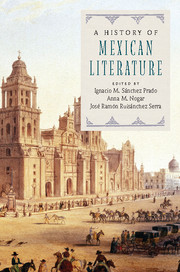Book contents
- Frontmatter
- Contents
- List of contributors
- Introduction
- PART I COLONIAL LITERATURE
- 1 The Languages and Literatures of Early Print Culture in the Colonia
- 2 A Chronicon of Crónicas: The New Spanish Prose Narrative
- 3 Theatricality and the Public Enactment of the Mexican Colonial
- 4 Sor Juana Inés de la Cruz: The Tenth Muse and the Difficult Freedom to Be
- 5 Jesuit Enlightenment: Interventions in Christianity and Intellectualism
- 6 Women in the Print Culture of New Spain
- 7 The Colonial Literary Scope: Empire, Letter, and Power
- 8 New Spain's Archival Past and Present Materiality
- PART II THE NINETEENTH CENTURY
- PART III TWENTIETH AND TWENTY-FIRST CENTURIES
- PART IV MEXICAN LITERATURE BEYOND BOUNDARIES
- Index
- References
4 - Sor Juana Inés de la Cruz: The Tenth Muse and the Difficult Freedom to Be
from PART I - COLONIAL LITERATURE
Published online by Cambridge University Press: 05 July 2016
- Frontmatter
- Contents
- List of contributors
- Introduction
- PART I COLONIAL LITERATURE
- 1 The Languages and Literatures of Early Print Culture in the Colonia
- 2 A Chronicon of Crónicas: The New Spanish Prose Narrative
- 3 Theatricality and the Public Enactment of the Mexican Colonial
- 4 Sor Juana Inés de la Cruz: The Tenth Muse and the Difficult Freedom to Be
- 5 Jesuit Enlightenment: Interventions in Christianity and Intellectualism
- 6 Women in the Print Culture of New Spain
- 7 The Colonial Literary Scope: Empire, Letter, and Power
- 8 New Spain's Archival Past and Present Materiality
- PART II THE NINETEENTH CENTURY
- PART III TWENTIETH AND TWENTY-FIRST CENTURIES
- PART IV MEXICAN LITERATURE BEYOND BOUNDARIES
- Index
- References
Summary
The life of Sor Juana Inés de la Cruz (Juana de Asbaje y Ramírez de Santillana, 1651?–1695), the “Phoenix of America” – “única poetisa, musa décima,” as she was declared in the first edition of her works, Inundación castálida (Madrid, 1689) – exerted a powerful seductive force during her life and continues to do so today. Octavio Paz, author of the major biography Sor Juana: Or, The Traps of Faith (1988, first published in Spanish in 1982), declared it “truly extraordinary that the most important writer of New Spain was a woman,” for the colonial-era literary and intellectual world was that of the male elite, in which literature was “written by men to be read by men” (Paz, 1988: 45). The scope of Sor Juana's output was all-encompassing in its reach and prodigious in its volume: “[h]er remarkably extensive writings essayed and enacted most of the (male) poetic, dramatic, theological and even philosophical discoveries of her times in the metropolis, making her works a compendium of baroque culture in its diversity and syncretism” (Merrim, 1999: xi). The Sor Juana that has transcended the centuries is never still: she was a cloistered nun, therefore theoretically “dead to the world,” but an international celebrity; she belonged to the colonial Creole intellectual elite, meaning that she existed between Old and New World cultures and structures of being and thinking; she was female, but her learning rendered her culturally and socially male; she was a religious who sought a path to God through learning, using the wisdom of the Virgin Mary as her model, while eschewing mysticism and asceticism. This chapter will explore the ways in which Sor Juana has been written into being, both by her own pen and by the pens of others, and how she fought to occupy a complex space between the public voice of the Creole intellectual and the cloistered silence of the nun.
A brief summary of the salient aspects of her life will set the scene. Sor Juana's life was driven by the need to follow her inclination, “casi insuperable” (OC [Obras completas], IV: 452), toward learning “este natural impulso que Dios puso en mí” (444).
- Type
- Chapter
- Information
- A History of Mexican Literature , pp. 66 - 80Publisher: Cambridge University PressPrint publication year: 2016
References
- 1
- Cited by



